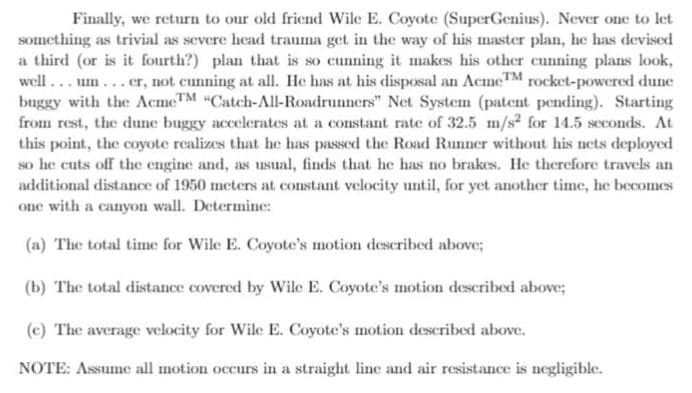Finally, we return to our old friend Wile E. Coyote (SuperGenius). Never one to let something as trivial as severe head trauma get in the way of his master plan, he has devised a third (or is it fourth?) plan that is so cunning it makes his other cunning plans look, well... um... er, not cunning at all. He has at his disposal an Acme™M rocket-powered dune buggy with the AemeTM "Catch-All-Roadrunners" Net System (patent pending). Starting from rest, the dune buggy accelerates at a constant rate of 32.5 m/s² for 14.5 seconds. At this point, the coyote realizes that he has passed the Road Runner without his nets deployed so he cuts off the engine and, as usual, finds that he has no brakes. He therefore travels an additional distance of 1950 meters at constant velocity until, for yet another time, he becomes one with a canyon wall. Determine: (a) The total time for Wile E. Coyote's motion described above; (b) The total distance covered by Wile E. Coyote's motion described above; (c) The average velocity for Wile E. Coyote's motion described above. NOTE: Assume all motion occurs in a straight line and air resistance is negligible.
Finally, we return to our old friend Wile E. Coyote (SuperGenius). Never one to let something as trivial as severe head trauma get in the way of his master plan, he has devised a third (or is it fourth?) plan that is so cunning it makes his other cunning plans look, well... um... er, not cunning at all. He has at his disposal an Acme™M rocket-powered dune buggy with the AemeTM "Catch-All-Roadrunners" Net System (patent pending). Starting from rest, the dune buggy accelerates at a constant rate of 32.5 m/s² for 14.5 seconds. At this point, the coyote realizes that he has passed the Road Runner without his nets deployed so he cuts off the engine and, as usual, finds that he has no brakes. He therefore travels an additional distance of 1950 meters at constant velocity until, for yet another time, he becomes one with a canyon wall. Determine: (a) The total time for Wile E. Coyote's motion described above; (b) The total distance covered by Wile E. Coyote's motion described above; (c) The average velocity for Wile E. Coyote's motion described above. NOTE: Assume all motion occurs in a straight line and air resistance is negligible.
Related questions
Question
need some help on this one!

Transcribed Image Text:Finally, we return to our old friend Wile E. Coyote (SuperGenius). Never one to let
something as trivial as severe head trauma get in the way of his master plan, he has devised
a third (or is it fourth?) plan that is so cunning it makes his other cunning plans look,
well ... um...er, not cunning at all. He has at his disposal an Acme™ rocket-powered dune
buggy with the AcmeTM "Catch-All-Roadrunners" Net System (patent pending). Starting
from rest, the dune buggy accelerates at a constant rate of 32.5 m/s? for 14.5 seconds. At
this point, the coyote realizes that he has passed the Road Runner without his nets deployed
so he cuts off the engine and, as usual, finds that he has no brakes. He therefore travels an
additional distance of 1950 meters at constant velocity until, for yet another time, he becomes
one with a canyon wall. Determine:
(a) The total time for Wile E. Coyote's motion described above;
(b) The total distance covered by Wile E. Coyote's motion described above;
(c) The average velocity for Wile E. Coyote's motion described above.
NOTE: Assume all motion occurs in a straight line and air resistance is negligible.
Expert Solution
This question has been solved!
Explore an expertly crafted, step-by-step solution for a thorough understanding of key concepts.
This is a popular solution!
Trending now
This is a popular solution!
Step by step
Solved in 4 steps with 6 images
